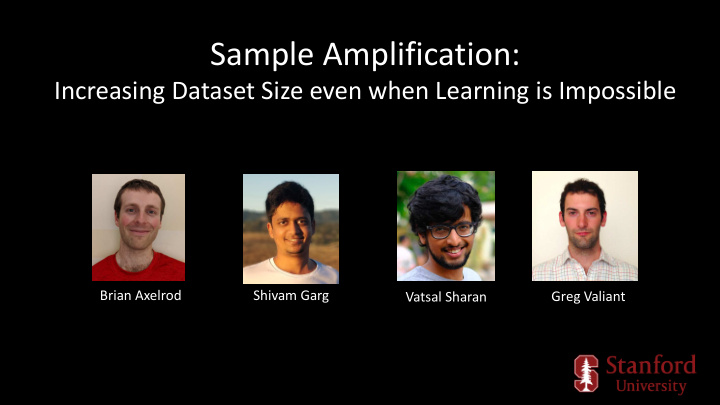



Sample Amplification: Increasing Dataset Size even when Learning is Impossible Brian Axelrod Shivam Garg Greg Valiant Vatsal Sharan
0 0 0 2 , 4 3 $ o r f r s u Y o What does it mean that a GAN made this image? (Does it mean that GANs “know” the distribution of renaissance portraits?)
When can you make more data? Could you generate new samples from a distribution, without even `` learning’’ it?
New Problem: Sample Amplification Amplifier Input: n i.i.d. samples from D Output: m > n “samples” Output: ACCEPT or REJECT Verifier Input: m samples, distribution D Promise: If input is m i.i.d. draws from D, then w. prob > ¾, must ACCEPT. Verifier: 1. Knows D 2. Is computationally unbounded 3. Does not know training set
Sample Amplification Definition: A class of distributions C admits ( n , m )-amplification, if there is an (n,m) Amplifer s.t. for all D ∈ C, any Verifier will ACCEPT with prob > 2/3. Verifier: knows D , is computationally unbounded
Sample Amplification Definition: A class of distributions C admits ( n , m )-amplification, if there is an (n,m) Amplifer s.t. for all D ∈ C, any Verifier will ACCEPT with prob > 2/3. • Every class C admits (n,n)-amplification (why?) • Verifier does not see Amplifier’s n input samples. (Otherwise equivalent to learning ) • Up to constant factors, equivalent to asking whether Amplifier can output m samples, whose T.V. distance to m i.i.d. samples from D is small.
Sample Amplification Definition: A class of distributions C admits ( n , m )-amplification, if there is an (n,m) Amplifer s.t. for all D ∈ C, any Verifier will ACCEPT with prob > 2/3. Connection to GANs: Amplifier -> Generator, Verifier -> Discriminator? Not quite.. Similarities in how samples are used and evaluated.
RESULTS
Sample Amplification Thm 1: Let C be class of discrete distributions supported on ≤ k elements. ( n, n + n/sqrt(k) )-amplification is possible (and optimal, to constant factors) * Nontrivial amplification possible as soon as n > sqrt(k). * Learning to nontrivial accuracy requires n= 𝜄 (k) samples * Even with n >> k can never amplify by arbitrary amount. Thm 2: Let C be class of Gaussians in d dimensions, with fixed covariance (e.g. “isotropic”), and unknown mean. ( n, n + n/sqrt(d) )-amplification is possible (and optimal, to constant factors) * Nontrivial amplification possible as soon as n > sqrt(d). * Learning to nontrivial accuracy requires n= 𝜄 (d) samples
GAUSSIAN DISTRIBUTION
Thm 2: For Gaussians in d dimensions, with fixed covariance, and unknown mean: • Learning requires n = d. • Amplification possible starting at n = sqrt(d) . ( n, n + n/sqrt(d) )-amplification is possible (and optimal, to constant factors) Algorithm: 1) Draw x n+1 …x m using empirical mean u* of input samples. 2) For each input sample x i “decorrelate” it from u*. 3) Return x n+1 …x m along with “decorrelated” original samples. Thm 3: If output ⊃ input samples, require n > d/ log d for nontrivial amp. Intuitively, issue is new “samples” would be too correlated with originals:
IS AMPLIFICATION USEFUL?
Amplification does not add new information, but could make original information more easily accessible. Can widely used statistical tools do better on amplified samples? Statistical Data estimator
Amplification does not add new information, but could make original information more easily accessible. Can widely used statistical tools do better on amplified samples? Statistical Amplifier Data Amplified Data estimator
Amplification Maybe Useful? Given examples (𝑦, 𝑧)~𝐸 estimate error of best linear model Standard unbiased estimator: Error of least-squares model, scaled down 𝑦~ 𝐻𝑏𝑣𝑡𝑡𝑗𝑏𝑜(𝑒 = 50), 𝑧 = 𝜄 8 𝑦 + 𝐻𝑏𝑣𝑡𝑡𝑗𝑏𝑜 𝑜𝑝𝑗𝑡𝑓 Error of classical estimator vs. same estimator on (𝑜, 𝑜 + 2) amplified samples.
Amplification Maybe Useful? Statistical Amplifier Data Amplified Data estimator
FUTURE DIRECTIONS
What property of a class of distributions determines threshold at which non-trivial amplification is possible? More general amplification schemes? MORE powerful How much does Verifier need to know about n input samples to preclude amplification without learning? Verifier? [How much do we need to know about a GAN’s input, to evaluate its output?] l u f r e w o p S S E ? What if Verifier doesn’t know D, only gets sample access? L r e i f i r e V
Amplifier THANK YOU!
Recommend
More recommend